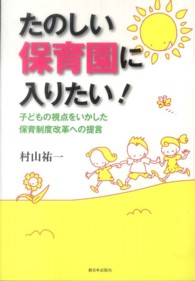- ホーム
- > 洋書
- > 英文書
- > Psychology
Full Description
The first and perhaps most important step in writing a treatment manual for use in clinical practice is to clearly explicate the logic of how the treatment, and hence the book, should be organized. Accordingly, our goal in this section is to lay out the structure of cognitive-behavioral therapy (CBT) for trichotillomania (TTM) and other body-focused impulse control disorders, clearly explaining critical decisions such as the chosen sequence of techniques or whether a given technique is considered a core component or a module to be used in some but not all cases. The structure of this particular book is influenced by the work of experts who have gone before us in pioneering CBT for TTM, and is also informed by over a decade of our own clinical work and research on TTM across the developmental spectrum. We are indebted to those who developed this approach to treatment and also to those who built the extant literature on the psychopathology of TTM and related disorders. These clinicians and researchers did so in order to help alle- ate the suffering of those afflicted with these conditions, and we endeavor to f- low in their footsteps in continuing this important work.
Contents
I. Overview and Assessment.- Trichotillo-What? Definition, Epidemiology, Impairment.- Putting it Together: Biopsychosocial Theory of TTM.- What it is and what it isn't: Diagnostics, Differential Diagnosis, Measures.- Doing the Detective Work: Comprehensive Assessment/Functional Analysis.- What Should be Done? Presentation of Treatment Alternatives (Including CBT).- What do We Need to Know? Frequently and Infrequently Asked Questions.- II. Treatment: Core Elements.- You Can't Fight What You Can't See: Awareness Training and Self-Monitoring.- Speed Bumps: Stimulus Control.- Active Strategies for Active Hands: Habit Reversal/Competing Response.-Holding the Lead: Maintenance.- III. Treatment: Adjunctive Modules.-Introduction to Section: What are these for? How do You Know if You Need Them?.- I'm not Sure if I'm Ready: Module 1: Motivational Enhancement.- Calming Down: Module 2: Relaxation/Deep Breathing.- Changing Your Thinking: Module 3: Cognitive Restructuring.- When other Problems are also Present: Module 4: Clinical Management of Comorbidity.- Attending to the Context: Module 5: Family Assessment and Family-Based Interventions.- Getting Support: Module 6: Group Based Interventions .- IV. Resources for Clinicians, Patients, and Families.- Comprehensive List of Professional and Informational Sources for Clinicians, Patients and Families.- Literature Cited.







